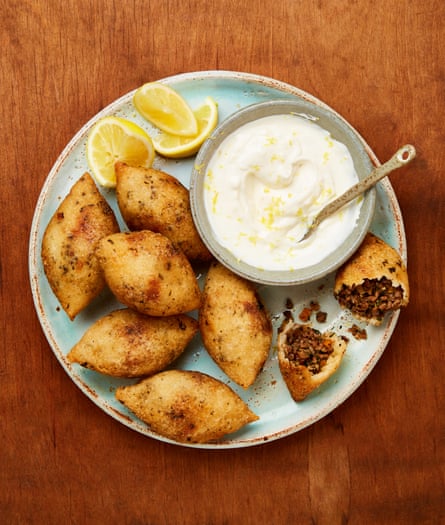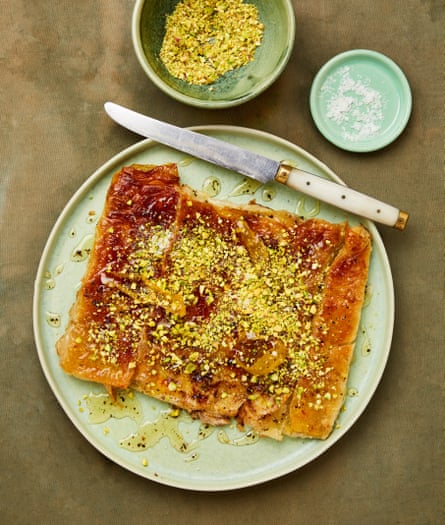I’m often asked the “favourite child” question. Not about my actual children, you understand, but my favourite cookbook, or recipe within a particular cookbook. I’m clearly duty-bound to say that I love all of my books and recipes (and children) equally, but I’ve decided that it is OK to love some books and recipes and types of food more at certain times of the year. For me, September – the new school term, the change in season – is always marked by me reaching for Jerusalem, the celebration of the food of the Middle East I wrote with Sami Tamimi, published 13 years ago this month – a teenager! It’s the food that bookends everything for me, wherever it sits on the bookshelf throughout the year.
Tahdig with golden raisins and orange blossom (pictured top)
Tahdig is a Persian rice dish, and the word translates literally to “bottom of the pan”, referring to the crisp bottom that forms during the cooking process. There is an element of surprise to making it, because you won’t know you have mastered the golden bottom until the finished article is turned out. A pan with even heat distribution (and, ideally, an induction hob) will be your friend here. Failing that, line the base of the pan with greaseproof paper to ensure the tahdig doesn’t stick. It’s a neat trick that pays off every time.
Soak 2 hr
Prep 10 min
Cook 1 hr 15 min
Serves 6 as a side
For the spiced rice
500g basmati rice, washed and soaked in plenty of cold water for 1 hour
130g Greek yoghurt
2 tbsp olive oil
2 tsp cumin seeds
10 cardamom pods, bashed open, pods discarded, and seeds crushed, to get ½ tsp
¼ tsp saffron threads, lightly crushed and soaked in 50ml hot water for 10 minutes
70g unsalted butter, cut into roughly 1½cm cubes
Fine sea salt
For the topping
25g pine nuts
2 tbsp olive oil
80g golden or regular raisins
40g sugar (any)
35ml apple cider vinegar
¼ tsp saffron threads, lightly crushed and soaked in 1 tbsp hot water for 10 minutes
1 tbsp orange blossom water (optional)
Fill a large saucepan three-quarters full with well-salted water (10g salt per litre ) and bring to a boil. Drain the rice and rinse several times with cold water until the water runs clear. Parboil the drained rice for five minutes, then drain again and rinse under cold water.
Put the yoghurt, a tablespoon of the olive oil, the cumin and the cardamom in a large bowl, then add three-quarters of the saffron and its liquid. Gently stir in 250g of the parboiled rice, until well coated.
Next, put another tablespoon of olive oil in a large, 22cm nonstick saute pan, swirl it around to coat, then press the saffron rice mixture evenly over the base of the pan. Using a large kitchen spoon, pile the remaining parboiled rice on top, to create a pyramid shape, then scatter over the cubed butter and the remaining saffron and its soaking liquid. With the handle of a wooden spoon, pierce five holes into the mix, right through to the base of the rice: this will let the steam escape while it’s cooking.
Wrap the lid for the pot with a clean tea towel (this will catch any steam), then cover the pan, making sure its sealed tightly. Turn on the heat to medium-high and leave to cook for five to seven minutes. When you hear a light sizzling sound from the base of the pan, turn down the heat to medium-low and cook for another 30 minutes – resist the urge to lift the lid, because that will let the steam (and the surprise!) out. Take the pan off the heat and leave to rest, still covered, for 10 minutes.
Meanwhile, make the topping. Put the pine nuts and oil in a small saucepan and cook on a medium heat for five minutes, just until the nuts are toasted and golden. Using a slotted spoon, lift the nuts into a small bowl. Add all the remaining topping ingredients to the hot oil in the pan, turn up the heat to medium-high and bring to a boil. Turn down the heat to a simmer and cook for five minutes, until the mixture is syrupy and golden, then stir into the pine nut bowl.
Put a large, round serving plate on top of the rice pan. Holding both the pan and the plate (and your breath!) tightly, quickly and carefully flip the whole thing over to release the tahdig. Ta-da! Pour the topping over the top of the crisp rice and serve.
Rice and lamb kubbes with lemon yoghurt

Kubbes come in many shapes and sizes, with every region making its own version with varying casings and fillings. This one uses rice as the casing and curry leaves as a twist; if you can’t get your hands on fresh curry leaves, swap them for any soft herbs you have to hand, such as dill or parsley. To get ahead, make the filling a day before, but don’t cook the rice until just before you form the kubbes, because it’s much easier to tease warm rice to form a casing.
Prep 25 min
Soak 1 hr
Cook 45 min
Makes 8
For the rice casing
200g basmati rice, soaked in plenty of cold water for at least an hour
30 fresh curry leaves, finely chopped, or 10g each fresh parsley and dill
500ml sunflower (or vegetable) oil, for frying
For the lamb filling
1 tbsp olive oil
1 onion (180g), peeled and finely chopped
2 garlic cloves, peeled and crushed
300g minced lamb
15g walnuts, toasted and finely chopped
¼ tsp chilli flakes
1¾ tsp ras el hanout
Fine sea salt and black pepper
10g picked dill, finely chopped
10g picked parsley, finely chopped
3-4 dried apricots (30g), finely chopped
For the lemon yoghurt
300g Greek yoghurt
1 tsp finely grated lemon zest and 1¼ tsp lemon juice
1 small garlic clove, peeled and crushed
First, make the filling. Put a medium saute pan on a medium-high heat and, once hot, add the oil, onion and garlic. Cook for five to seven minutes, until softened, then add the lamb, walnuts, chilli flakes, ras el hanout, three-quarters of a teaspoon of salt and a good grind of black pepper. Break up the mince and cook, stirring often, for 10-12 minutes, until lightly browned.
Off the heat, stir in the dill, parsley and apricots, then set aside to cool. Once the mixture is completely cool, use your hands to divide it into eight equal 40g portions, form each one into a 40g ball balls and put on a tray. If you’re making them ahead, cover and refrigerate.
Next, cook the rice. Put 700ml water and a teaspoon and a half of salt in a large saucepan and bring to a boil. Add the rice, turn down the heat to medium and cook for eight to 10 minutes, until slightly overcooked, then drain well. While the rice is still hot, spoon it into a ricer (or use a fork) and mash it into a bowl. Stir in the curry leaves (or soft herbs).
Now set up your kubbe-making station. Put a small bowl of cold water next to the rice bowl. Weigh out eight 60-70g balls of the rice mix; keep any excess for patching up the kubbes. With slightly wet hands, press a ball of the rice flat on to the palm of one hand. Put one of the mince balls on top and fold the rice over the top to encase it completely – you may need to push the rice along a bit to do this; if need be, use some of the leftover rice to patch things up. Making sure your hands are still wet, press the kubbe into an oblong and put on a tray. Repeat with the remaining rice and filling.
To fry the kubbes, put the oil in a medium saute pan on a medium -high heat. Once hot, fry the kubbes in batches of two or three for five to six minutes, turning as required, until lightly golden and crisp all over. With a slotted spoon, transfer to a plate lined with kitchen paper, to drain, and repeat with the remaining kubbes. If need be, keep the cooked kubbes warm in a low oven.
Put all the ingredients for the lemon yoghurt in a bowl, add a half-teaspoon of salt and freshly ground black pepper to taste, and mix well.
When all the kubbes are cooked, arrange them on a platter and serve with the yoghurt alongside for dipping.
Feta and kaymak katmer with pistachios and lemon syrup

Katmer is a dessert from Gaziantep in Turkey that’s traditionally made with kaymak, the local clotted cream. You can find it in most Middle Eastern shops, but if you can’t get hold of any, use Cornish clotted cream instead. As a twist, we’ve added feta and a lemony cardamom syrup to our katmer. Serve with seasonal berries and/or orange segments, if you like.
Prep 15 min`
Cook 20 min
Makes 2
For the katmer
4 sheets filo pastry
50g unsalted butter, melted
60g shelled pistachios, toasted and very finely chopped
160g kaymak, or clotted cream
40g feta
For the lemon syrup
100g caster sugar
10 cardamom pods, bashed open, pods discarded, seeds crushed in a mortar to get ½ tsp
1 lemon, peeled, to get 6 strips of zest, and juiced, to get 2 tsp
Flaked sea salt, to serve
First make the syrup. Put the sugar, cardamom, lemon peel and 200ml water in a small saucepan on a medium-high heat, and simmer for 10 minutes, until the mixture is thick and syrupy and the lemon zest has candied.
Meanwhile, assemble the katmer. Working quickly, put one sheet of filo on a work surface, brush it generously with butter, lay a second sheet on top and brush with more butter. Leaving a 3cm border around the edge, scatter over 20g of the chopped pistachios, dot over half the cream and crumble over half the feta. Fold one short end of the filo into the middle, then fold over the opposite short end to cover the cheese mix completely. Brush the ends with more butter to seal, then fold over 2cm of the exposed ends to close up the pastry entirely. Repeat with the remaining two sheets of filo, cream, cheese and 20g pistachios to make a second katmer.
Put a large frying pan on a medium heat. Brush the seam side of one katmer with butter, then lay it seam side down in the hot pan and leave to cook for seven minutes, until deeply golden and crisp. Brush the uncooked side with more butter, flip over and cook for another three to four minutes, until the other side is also deeply golden and crisp. Transfer to a plate and repeat with the second katmer.
Stir the lemon juice into the syrup, then spoon half of it over each katmer, along with half the candied zest. Serve with the remaining 20g pistachios and a pinch of flaked sea salt scattered on top.
Article From & Read More ( Yotam Ottolenghi’s Middle Eastern recipes for early autumn - The Guardian )https://ift.tt/Y2dU5Ae
Entertainment
No comments:
Post a Comment